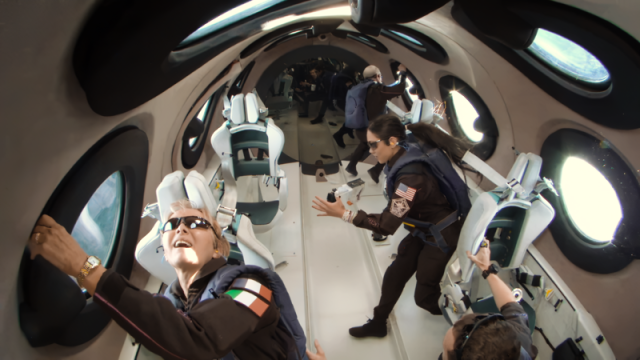After landing back to Earth from Virgin Galactic’s latest suborbital flight, planetary scientist Alan Stern and science communicator Kellie Gerardi received a ton of text messages from other researchers asking, “How do I get to do that?”
The pair were part of the Galactic 05 mission, which transported them to the edge of space on Thursday on board the company’s VSS Unity spaceplane. The mission used the spaceship as a suborbital lab to conduct space-based scientific research, providing unique access for researchers to carry out their experiments in the microgravity environment.
“I think you’d be hard pressed to find anyone who wouldn’t jump at the chance,” Gerardi told Gizmodo during a phone interview on Thursday.
The flight lasted for around an hour, and reached an altitude of 54.2 miles (87 kilometres) above the surface of Earth. During that time, Gerardi tended to three payloads on behalf of the International Institute for Astronautical Sciences (IIAS), one of which is a sensor that measured blood glucose levels during the flight to investigate whether long duration spaceflight induces insulin resistance (a pre-diabetogenic stage).
Stern, who is best known as the principal investigator of NASA’s New Horizons mission to Pluto, wore a biomedical harness to assess researchers’ reactions to high G-forces and the microgravity environment. He also operated a wide-field visible and ultraviolet camera to test it during suborbital flights.
“Normally I work in a control room and I’m sending commands to a robot or sometimes coaching an astronaut through an experiment on the [International Space Station,]” Stern told Gizmodo. “In this case, I was doing it entirely myself…and everything is compressed in less than 200 seconds.”
Galactic 05 is the company’s second research mission since Virgin Galactic launched its commercial spaceflight program this summer. The first mission, Galactic 01, involved a three-person crew from the Italian Air Force and the National Research Council of Italy, who carried out microgravity research on board Virgin Galactic’s VSS Unity spaceplane.
Stern has long been an advocate of using suborbital flights such as this one to conduct research in microgravity, and he is also training for a future flight as part of NASA’s Flight Opportunities program. Suborbital research has been around since the 1950s with rocket-powered vehicles and high-altitude balloons, but the commercialization of space has contributed to making this type of research more accessible as of late.
“We’re living through an era where companies like Virgin are making it possible to dream up all kinds of new use cases because you can fly so frequently at affordable prices,” Stern said. “We’re at that Goldilocks spot.”
Aside from carrying out the research on board Galactic 05, Gerardi and Stern also enjoyed the thrill that comes along with the ride. “You feel like you’re just going straight up to the stars,” Gerardi said.
Stern also shared in the excitement of those early moments of ascending to the skies. “It almost looks like a tunnel because the sky is black and the bright part of the sky that we all see down here is fading away. It was super cool,” he said.
